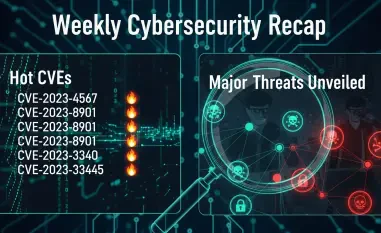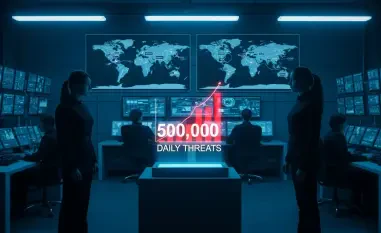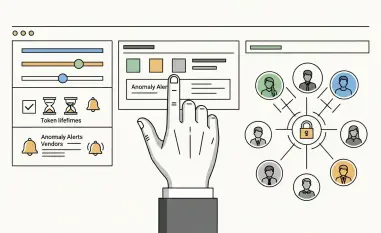Imagine a digital tsunami crashing against the shores of internet infrastructure, with a force so immense that it threatens to drown entire online ecosystems in mere seconds, highlighting the critical need for robust cybersecurity measures. This is the reality of a staggering 11.5 terabits per second (Tbps) Distributed Denial of Service (DDoS) attack, recently mitigated by Cloudflare, marking it as the largest of its kind ever recorded. Such an event underscores the escalating cyber threats facing businesses and service providers today, where a single assault can disrupt operations on a global scale. As the cybersecurity industry grapples with these intensifying challenges, this report delves into the dynamics of DDoS attacks, their implications, and the strategies needed to safeguard the digital landscape.
The Rising Threat of DDoS Attacks in the Cybersecurity Landscape
The cybersecurity sector stands at a critical juncture, confronting an unprecedented surge in DDoS attacks that aim to overwhelm servers, networks, and online services with malicious traffic. These attacks have evolved from mere nuisances to sophisticated weapons capable of crippling major enterprises, e-commerce platforms, and even critical infrastructure. With financial losses mounting and reputational damage becoming a significant concern, the stakes for businesses have never been higher in maintaining an uninterrupted online presence.
Key players like Cloudflare play a pivotal role in this battle, offering robust mitigation solutions to absorb and deflect malicious traffic before it reaches its target. Their efforts highlight the broader implications for internet infrastructure, where the resilience of digital services is paramount to global connectivity and economic stability. Without such defenses, organizations risk prolonged downtime, which can translate into millions in lost revenue and eroded customer trust.
A driving force behind the rise of these threats is the proliferation of connected devices, particularly through the Internet of Things (IoT). As billions of gadgets—from smart home appliances to industrial sensors—join the network, many lack adequate security, creating fertile ground for exploitation by cybercriminals. This technological expansion, while innovative, amplifies the attack surface, making DDoS a persistent and growing menace in the cybersecurity arena.
Unpacking the Record-Breaking 11.5 Tbps Attack
Details of the Unprecedented UDP Flood Incident
In a remarkable display of cyber defense, Cloudflare recently neutralized a DDoS attack peaking at an astonishing 11.5 Tbps, setting a new benchmark for attack magnitude. This User Datagram Protocol (UDP) flood incident lasted a mere 35 seconds but unleashed a staggering 5.1 billion packets per second, showcasing the sheer intensity of modern cyber assaults. Such scale demonstrates how attackers are leveraging advanced techniques to maximize disruption in minimal time.
When compared to prior benchmarks, this event eclipses the previous record of 7.3 Tbps, illustrating a rapid escalation in attack capabilities. Another notable incident occurred just days earlier, on October 29 of the prior year, with a UDP-based assault reaching 5.6 Tbps over 80 seconds. These figures reveal a disturbing trend of increasingly powerful attacks, pushing the boundaries of what cybersecurity defenses must withstand to protect digital assets.
Surge in Attack Frequency and Scale
Beyond individual incidents, the broader landscape shows a dramatic uptick in DDoS activity, with a reported 108% increase globally from the previous year to the current one. This surge reflects not just isolated spikes but a systemic growth in cyber aggression, posing challenges for organizations across industries. The sheer volume of malicious attempts underscores the urgency for enhanced protective measures on a worldwide scale.
Cloudflare alone mitigated 20.5 million attacks in the most recent annual cycle, marking a staggering 358% rise compared to the year before. This exponential growth signals that DDoS attacks are not only becoming more frequent but also more coordinated, often targeting multiple entities simultaneously. Such trends suggest that the future of cybersecurity will demand innovative solutions to keep pace with evolving threats.
The implications of this escalation are profound, as businesses face heightened risks of service interruptions and operational setbacks. As attack scales continue to grow, the pressure on cybersecurity providers intensifies, necessitating investments in cutting-edge technologies and strategies to anticipate and neutralize threats before they inflict irreversible damage.
Key Challenges in Combating DDoS Threats
Mitigating DDoS attacks presents formidable hurdles, chief among them being the exploitation of vulnerable IoT devices by sprawling botnets. These networks of compromised devices, often numbering in the tens of thousands, are harnessed to amplify attack traffic, overwhelming targets with ease. The inherent insecurity of many connected gadgets, often prioritized for cost over protection, creates a persistent weak link in the digital chain.
Another pressing issue is the professionalization of cybercrime, where attackers can orchestrate devastating assaults for a minimal cost—as low as five dollars per hour through online marketplaces. This stark asymmetry between the low investment for attackers and the high impact on victims, such as online retailers facing massive revenue losses, complicates defense efforts. The accessibility of such services fuels a thriving underground economy focused on disruption and extortion.
Addressing these challenges requires multifaceted approaches, including bolstering device security at the manufacturing level to prevent exploitation. Disrupting botnet operations through coordinated global efforts and advanced threat intelligence can also curb attack capabilities. Furthermore, fostering industry-wide collaboration to share insights and best practices remains essential to stay ahead of increasingly organized cyber adversaries.
The Role of IoT Vulnerabilities and Regulatory Gaps
IoT devices, often designed with limited computational power and budget constraints, frequently lack robust security features, making them prime targets for botnets like Mirai and Bashlite. These malware strains can hijack thousands of devices, turning them into tools for large-scale DDoS attacks. As botnet sizes grow—averaging 38,000 units by the end of the latest reporting period—the potential for catastrophic disruptions escalates.
Compounding this issue is the absence of stringent regulations and standardized security protocols for IoT products. Without mandatory compliance measures, manufacturers have little incentive to prioritize cybersecurity over cost savings, leaving vast networks of devices exposed. This regulatory gap not only endangers individual users but also undermines the integrity of broader internet infrastructure.
The impact of these shortcomings necessitates urgent action through global cooperation to establish enforceable cybersecurity frameworks. Governments, industry leaders, and standards bodies must work in tandem to mandate security benchmarks for connected devices. Until such policies are in place, the cycle of exploitation and attack will persist, hampering efforts to secure the expanding digital ecosystem.
Future Outlook: Escalating Threats and Emerging Defenses
Looking ahead, DDoS attacks are expected to grow in both sophistication and frequency, driven by technological advancements and the increasing organization of cybercrime networks. As attackers refine their methods and leverage emerging tools, the potential for even larger-scale disruptions looms large. This trajectory signals a pressing need for proactive measures to safeguard critical online services.
Emerging defenses offer hope, with potential solutions including enhanced IoT security protocols and advanced mitigation technologies capable of detecting and neutralizing threats in real time. Additionally, rising consumer awareness about device security could drive demand for safer products, pressuring manufacturers to prioritize protection. These innovations, if widely adopted, could shift the balance toward stronger digital resilience.
External factors, such as global economic conditions and evolving regulatory landscapes, will also shape the cybersecurity domain. Economic downturns might limit investments in defense mechanisms, while progressive legislation could enforce stricter security standards. Businesses must remain agile, adapting to these influences to bolster their defenses against an ever-changing array of cyber threats.
Conclusion: Navigating the Evolved DDoS Threat Landscape
Reflecting on the insights gathered, the record-shattering 11.5 Tbps attack mitigated by Cloudflare stood as a stark reminder of the escalating dangers in the digital realm. The alarming 108% rise in global DDoS incidents and the mitigation of 20.5 million attacks in a single year painted a picture of a threat landscape that had grown both in scale and complexity. These events highlighted the critical vulnerabilities in IoT ecosystems and the low barriers to entry for cybercriminals launching devastating assaults.
Moving forward, actionable steps emerged as vital to counter these challenges, starting with a concerted push to enhance security at the device level and disrupt botnet operations through international collaboration. Investment in cutting-edge mitigation technologies offered a pathway to anticipate and neutralize threats before they struck. Equally important was the advocacy for robust regulatory frameworks to enforce IoT security standards, ensuring that innovation did not come at the expense of safety.
Beyond immediate solutions, the broader consideration was fostering a culture of resilience among businesses and service providers, encouraging proactive risk management and knowledge sharing. By aligning efforts across industries and governments, the groundwork was laid for a more secure digital future. This collective approach promised to transform the fight against DDoS attacks, turning a reactive stance into a strategic defense against the evolving tactics of cyber adversaries.













